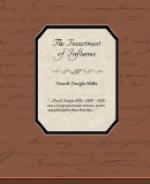This law of self-sacrifice is imbedded in nature. Minot, the embryologist, and Drummond, the scientist, tells us that only by losing its life does the cell save it. The new science exhibits the body as a temple, constructed out of cells, as a building is made of bricks. Just as some St. Peter represents strange marble from Athens, beauteous woods from Cyprus, granite from Italy, porphyry from Egypt, all brought together in a single cathedral, so the human body is a glorious temple built by those architects called living cells. When the scientist searches out the beginning of bird or bud or acorn he comes to a single cell. Under the microscope that cell is seen to be absorbing nutrition through its outer covering. But when the cell has attained a certain size its life is suddenly threatened. The center of the cell is seen to be so far from the surface that it can no longer draw in the nutrition from without. The bulk has outrun the absorbing surface. “The alternative is very sharp,” says the scientist, “the cell must divide or die.” Only by losing its life and becoming two cells can it save its life.
Later on, when each of the two cells has grown again to the size of the original one, the same peril threatens them and they too must divide or die. And when through this law of saving life by losing it nature has made sure the basis for bud and bird, for beast and man, then the principle of sacrifice goes on to secure beauty of the individual plant or animal and perpetuity for the species. In the center of each grain of wheat there is a golden spot that gives a yellow cast to the fine flour. That spot is called the germ. When the germ sprouts and begins to increase, the white flour taken up as food begins to decrease. As the plant waxes, the surrounding kernel wanes. The life of the higher means the death of the lower. In the orchard also the flower must fall that the fruit may swell. If the young apple grows large, it must begin by pushing off the blossom. But by losing the lower bud, the tree saves the higher fruit.
Centuries ago Herodotus, the Grecian traveler, noted a remarkable custom in Egypt. Each springtime, when the palms flowered, the Egyptians went into the desert, cut off branches from the wild palms and, bringing them back to their gardens, waved them over the flowers of the date trees. What was meant by this ceremony Herodotus did not know. The husbandmen believed that if they neglected it the gods would give them but a scanty crop of dates. It was reserved for the science of our century, through Drummond, to explain the fact that the one palm saved its dates because the other palm lost its fertilizing pollen. Should nature refuse to obey this law of losing life in order to save it, man’s world would become one vast Sahara waste, an arctic desolation.




